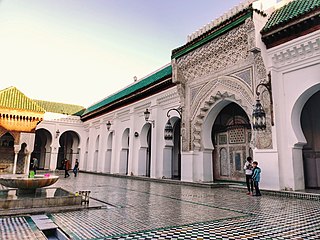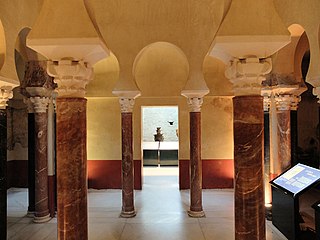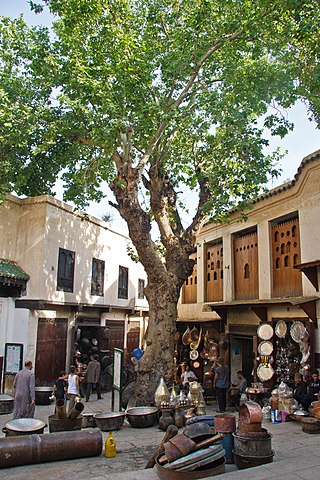
A hammam, called a Moorish bath and a Turkish bath by Westerners, is a type of steam bath or a place of public bathing associated with the Islamic world. It is a prominent feature in the culture of the Muslim world and was inherited from the model of the Roman thermae. Muslim bathhouses or hammams were historically found across the Middle East, North Africa, al-Andalus, Central Asia, the Indian subcontinent, and in Southeastern Europe under Ottoman rule.

Moroccan architecture reflects Morocco's diverse geography and long history, marked by successive waves of settlers through both migration and military conquest. This architectural heritage includes ancient Roman sites, historic Islamic architecture, local vernacular architecture, 20th-century French colonial architecture, and modern architecture.

The Chellah or Shalla, is a medieval fortified Muslim necropolis and ancient archeological site in Rabat, Morocco, located on the south (left) side of the Bou Regreg estuary. The earliest evidence of the site's occupation suggests that the Phoenicians established a trading emporium here in the first millennium BC. This was later the site of Sala Colonia, an ancient Roman colony in the province of Mauretania Tingitana, before it was abandoned in Late Antiquity. In the late 13th century the site began to be used as a dynastic necropolis for the Marinid dynasty. By the mid-14th century Marinid sultans had enclosed a part of the site with a new set of walls and built a religious complex inside it to accompany their mausoleums. In the 15th century the necropolis began to decline and it suffered damage over the centuries due to earthquakes and looting. Archeological excavations in the 20th century unearthed the remains of the ancient Roman town. Today the site is a tourist attraction and since 2012 it forms part of a UNESCO World Heritage Site.

The banya is a traditional Russian steam bath that utilizes a wood stove. It is a significant part of Russian culture, and is typically conducted in a small room or building designed for dry or wet heat sessions. The high heat and steam cause bathers to perspire, and traditionally, genders were segregated in the banya, with separate rooms for each sex.

The Museum of Marrakech is a historic palace and museum located in the old center of Marrakesh, Morocco. In addition to its notable architecture, the museum's collection showcases various historic art objects and contemporary art from Morocco.

El Badi Palace or Badi' Palace is a ruined palace located in Marrakesh, Morocco. It was commissioned by the sultan Ahmad al-Mansur of the Saadian dynasty a few months after his accession in 1578, with construction and embellishment continuing throughout most of his reign. The palace, decorated with materials imported from numerous countries ranging from Italy to Mali, was used for receptions and designed to showcase the Sultan's wealth and power. It was one part of a larger Saadian palace complex occupying the Kasbah district of Marrakesh.

Moorish architecture is a style within Islamic architecture which developed in the western Islamic world, including al-Andalus and what is now Morocco, Algeria, and Tunisia. Scholarly references on Islamic architecture often refer to this architectural tradition in terms such as architecture of the Islamic West or architecture of the Western Islamic lands. The use of the term "Moorish" comes from the historical Western European designation of the Muslim inhabitants of these regions as "Moors". Some references on Islamic art and architecture consider this term to be outdated or contested.

The Ibn Danan Synagogue is a synagogue in Fes, Morocco, dating from the 17th century. The synagogue is located in the Mellah district within Fes el-Jdid, one of the components of the historic medina of Fes.

Fez or Fes is a city in northern inland Morocco and the capital of the Fès-Meknès administrative region. It is the second largest city in Morocco, with a population of 1.11 million, according to the 2014 census. Located to the northwest of the Atlas Mountains, it is surrounded by hills and the old city is centered around the Fez River flowing from west to east. Fez has been called the "Mecca of the West" and the "Athens of Africa". It is also considered the spiritual and cultural capital of Morocco.

The Caliphal Baths are an Islamic bathhouse complex in Córdoba, Spain. They are situated in the historic centre which was declared a World Heritage Site by UNESCO in 1994. The complex was contiguous to the former Caliphal Palaces of the Umayyads, whose inhabitants it served. Today the baths have been partially reconstructed and are open as a museum.

Saffarin Madrasa is a madrasa in Fes el-Bali, the old medina quarter of Fez, Morocco. It was built in 1271 CE by the Marinid Sultan Abu Ya'qub Yusuf and was the first of many madrasas built by the Marinid dynasty during their reign. It is located just south of the 9th-century Qarawiyyin Mosque on Saffarin Square, which is named after the coppersmiths who work in the square.

The Chrabliyine Mosque is a Marinid-era mosque in Fez, Morocco.

The architecture of Fez, Morocco, reflects the wider trends of Moroccan architecture dating from the city's foundation in the late 8th century and up to modern times. The old city (medina) of Fes, consisting of Fes el-Bali and Fes el-Jdid, is notable for being an exceptionally well-preserved medieval North African city and is classified as a UNESCO World Heritage Site. A large number of historic monuments from different periods still exist in it today, including mosques, madrasas, synagogues, hammams (bathhouses), souqs (markets), funduqs (caravanserais), defensive walls, city gates, historic houses, and palaces.

The Lalla ez-Zhar Mosque, or al-Zahr Mosque, is a mosque located in Fes el-Jdid in the historic old city of Fez, Morocco. It is also known by the name Jama’ el-Hajjar, probably in reference to its stone portal entrance. The mosque was founded or completed in 1357 CE by the Marinid sultan Abu Inan.

Dar Moqri is a historic palace or group of mansions in Fes el-Bali, the old medina of Fes, Morocco. It dates from the late 19th and early 20th centuries and was built by the wealthy and powerful Moqri family. The site is occupied by two grand residences built separately by members of the same family but physically adjoining each other. The older palace was begun by Abdelsalam al-Moqri and probably further modified by his son Muhammad. In addition to its rich interior, it is notable for its large terraced garden. The second palace belonged to his grandson Si Tayb and is notable for its long courtyard which mixes Italianate details with traditional Moroccan decoration. A completely separate palace, known as Riad Driss Moqri, was also built further north by Abdelsalam's son, Si Dris.

Place Seffarine or Seffarine Square is a small square in the medina of Fes, Morocco. It is located on the south side of the Qarawiyyin Mosque, close to the Bou Khrareb River which runs through the heart of the medina. The square dates back to the Middle Ages but has also undergone renovations in modern times. It is adjoined by the Qarawiyyin's library to the northwest, by the Saffarin Madrasa to the east, and by the Saffarin Hammam (bathhouse) to the southwest. It is named after the coppersmiths who have had their workshops here for centuries.
Hammam al-Mokhfiya is a historic hammam (bathhouse) in the medina of Fes, Morocco. It is located in the neighbourhood of the same name (al-Mokhfiya), south of Place R'cif. Based on its similarities in layout and decoration with other historic hammams in the region, it has been dated to the mid-14th century, during the reign of the Marinid sultan Abu Inan or slightly after. The hammam is richly decorated with carved stucco and carved wood in its changing room, as well as zellij tiling in its steam rooms. The hammam was part of the habous (endowment) of the Qarawiyyin Mosque.
Hammam Ben Abbad or Hammam Ibn Abbad is a historic hammam (bathhouse) in the medina of Fes, Morocco. It is located in the Kettanin neighbourhood south of the Zawiya of Moulay Idris, near the Funduq Kettanin. The hammam dates from the 14th century and was recently restored during a major rehabilitation program involving over two dozen other historic monuments in the city. Its name comes from a local Muslim saint who is associated with the building, and the waters of the hammam were believed to have healing properties. Entered from the north, the hammam has the usual series of rooms inherited from the Roman bathhouse model: an undressing room, a cold room (frigidarium), warm room (tepidarium), and a hot room (calderium). The hammam was part of the habous (endowment) of the Qarawiyyin Mosque.

The Bañuelo or El Bañuelo, also known as the Baño del Nogal or Hammam al-Yawza, is a preserved historic hammam in Granada, Spain. It is located in the Albaicin quarter of the city, on the banks of the Darro River. It was used as a bathhouse up until the 16th century at least, before becoming defunct and being converted to other uses. In the 20th century it underwent numerous restorations by Spanish experts and is now open as a tourist attraction.

The Tahtakale Hamam is a historic Ottoman hammam building in Istanbul, Turkey, close to the Rüstem Pasha Mosque in the Tahtakale neighbourhood, between the Grand Bazaar and Eminönü. Built during the reign of Sultan Mehmet II, it is one of the oldest surviving bathhouses in the city. After having suffered significant damage while being used as a storage depot in the 20th century, the building was restored in the late 1980s and now serves as a local shopping centre and cafe.


















